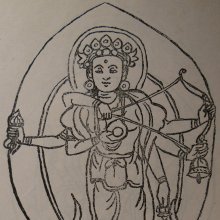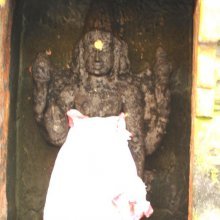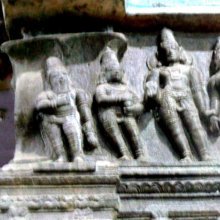Kamandalu, Kamaṇḍalu, Kamamdalu: 28 definitions
Introduction:
Kamandalu means something in Buddhism, Pali, Hinduism, Sanskrit, Marathi, Jainism, Prakrit. If you want to know the exact meaning, history, etymology or English translation of this term then check out the descriptions on this page. Add your comment or reference to a book if you want to contribute to this summary article.
Images (photo gallery)
(+17 more images available)
In Hinduism
Shilpashastra (iconography)
Source: Google Books: Elements of Hindu iconographyKamaṇḍalu (कमण्डलु).—This is an ordinary vessel to hold water and is of different shapes. It has in some cases a spout. The earlier specimens are simple in design, though not very handsome in appearance. The later forms are more symmetrical and beautiful in design and workmanship.
Source: Google Books: Sarasvatī: Riverine Goddess of Knowledge (iconography)Kamaṇḍalu (कमण्डलु, “water pot”).—An object being held by the four-armed Sarasvatī;—As a water-related river goddess, the water pot is an implement appropriate to Sarasvatī. According to Marie-Thérèse de Mallmann, it represents abundance or immortality. The Viṣṇudharmottara-purāṇa, on the other hand, tells us the water pot is to be known as the immortal nectar of all scriptures (śāstra).
Source: Red Zambala: Hindu Icons and Symbols | IntroductionKamaṇḍalu (water jug) - Fullness and generosity, also purity and purification.
Source: Shodhganga: The significance of the mūla-beras (śilpa)Kamaṇḍalu (“holy jug”) refers to one of the several “attributes” (āyudha) or “accessories” of a detiy commonly seen depicted in Hindu iconography, defined according to texts dealing with śilpa (arts and crafs), known as śilpaśāstras.—The śilpa texts have classified the various accessories under the broad heading of āyudha or karuvi (implement), including even flowers, animals, and musical instruments. The other miscellaneous articles found as attributes in the hands of the deities are, for example, Kamaṇḍalu.

Shilpashastra (शिल्पशास्त्र, śilpaśāstra) represents the ancient Indian science (shastra) of creative arts (shilpa) such as sculpture, iconography and painting. Closely related to Vastushastra (architecture), they often share the same literature.
Purana and Itihasa (epic history)
Source: archive.org: Shiva Purana - English TranslationKamaṇḍalu (कमण्डलु) refers to a particular type of Vessel (given by Brahmā), according to the Śivapurāṇa 2.4.5 (“Kārttikeya is crowned”).—Accordingly, after the Kṛttikās spoke to Kārttikeya: “[...] Then Śiva, the lord of the universe, following the worldly convention delightedly placed Kārttikeya on a beautiful gemset throne. [...] Śiva gave him the trident, the bow Pināka, the axe, the arrow Paśupata, the weapon of destruction and the greatest lore. I gave him the holy thread, the Vedas, the mantra Gāyatrī, the vessel Kamaṇḍalu, the arrow Brahmāstra and the lore that destroys the enemy. [...]”.
Source: Cologne Digital Sanskrit Dictionaries: The Purana IndexKamaṇḍalu (कमण्डलु).—Of Budha;1 in possession of Agastya.2 Given to Vāmana by Vasiṣṭha;3 of Brahmā, as the source of Gaṅgā;4 of Śiva.5
- 1) Matsya-purāṇa 11. 55.
- 2) Ib. 61. 36.
- 3) Ib. 245. 86.
- 4) Vāyu-purāṇa 55. 14; Bhāgavata-purāṇa VIII. 21. 4.
- 5) Vāyu-purāṇa 101. 273.

The Purana (पुराण, purāṇas) refers to Sanskrit literature preserving ancient India’s vast cultural history, including historical legends, religious ceremonies, various arts and sciences. The eighteen mahapuranas total over 400,000 shlokas (metrical couplets) and date to at least several centuries BCE.
Shaktism (Shakta philosophy)
Source: Google Books: ManthanabhairavatantramKamaṇḍalu (कमण्डलु) refers to a “water-pot”, according tot the Mṛgendrāgama (Caryāpāda) verse 18-19, in the section on expiation (prāyaścitta).—Accordingly, “One who observes a vow sleeps on the ground and gives up meat, women and wine. Alone, he takes care of the accoutrements (mātrā) of one who observes a vow) and, alone, his (sole) companion is a water pot (kamaṇḍalu). He avoids entertainment afforded by women, song, dance or (idle) chat. He does not live with a woman and avoids (wearing) garlands, smearing (his body with scented oils) and the like”.
Source: ORA: Amanaska (king of all yogas): (shaktism)Kamaṇḍalu (कमण्डलु) (or Kamaṇḍala) refers to a “pitcher”, according to the 17th century Kaulagajamardana (“crushing the Kaula elephant”) authored by Kāśīnātha or Kṛṣṇānandācala.—Accordingly, [as Īśvara said to Pārvatī]: “[...] O great Goddess, hear about the Jain. He always carries a pitcher (kamaṇḍalu-dhara). He is simply a soul and never an enjoyer, doer and destroyer. He is called a Jain, and Buddhists and [the like] are considered [to be similar]. Some pluck out their hair and dress in white, my dear, and [some] wear red garments and [others wear] indigo and so on. Some are called, 'great guru', and others pursue nonviolence. These are the different varieties in brief; they are [all] called Pāṣaṇḍas [because] they have been excluded from the vedic path. [...]”

Shakta (शाक्त, śākta) or Shaktism (śāktism) represents a tradition of Hinduism where the Goddess (Devi) is revered and worshipped. Shakta literature includes a range of scriptures, including various Agamas and Tantras, although its roots may be traced back to the Vedas.
Shaivism (Shaiva philosophy)
Source: Brill: Śaivism and the Tantric TraditionsKamaṇḍalu (कमण्डलु) refers to a “spouted water-pot”, according to the Kiraṇatantra chapter 49 (dealing with vratacaryā).—Accordingly, “Garuḍa spoke: ‘You have taught me, O great Lord, the activities of the Neophyte, the Putraka and the Ācārya. Tell me those of the Sādhaka’. The Lord spoke: ‘[...] Accompanied by his ritual assistant, he should go to the forest and begin the practice of his religious observance. [If he is] without a ritual assistant, then his spouted water-pot (kamaṇḍalu) is his ritual assistant in that [practice]. Alternatively, [instead of a kamaṇḍalu], it may be a gourd with a shaft. Having made this [ready], he should practise his observance. [...]’”.
Source: SOAS University of London: Protective Rites in the Netra Tantra1) Kamaṇḍalu (कमण्डलु) refers to a “water jar”, according to the Netratantra of Kṣemarāja: a Śaiva text from the 9th century in which Śiva (Bhairava) teaches Pārvatī topics such as metaphysics, cosmology, and soteriology.—Accordingly, [verse 9.19cd-26, while instructing to visualize Sadāśiva in order to worship the formless Amṛteśa]—“[He] resembles the swelling moon, a heap of mountain snow. [...] [Sadāśiva has] a shield, a mirror, a bow, a citron tree, and a water jar (kamaṇḍalu). At his head is a half moon. [He who meditates of Sadāśiva] should perceive the Eastern face as yellow; the Southern a wrathful, terrible black [that has] an unnatural, tusked mouth. [...]”.
2) Kamaṇḍalu (कमण्डलु) refers to a “water jar” (in a dream), according to the Svacchanda-tantra.—Accordingly, [verse 4.8-13, while describing auspicious dreams]—“[...] [It is auspicious when one dreams of] a pill, wood for cleaning the teeth, yellow pigment on a sword or sandal, sacred thread, ointment, nectar, mercury, medicinal herbs, śakti, a water jar (kamaṇḍalu), lotus, rosary, red arsenic or blazing objects of siddhas, which have red chalk as their ends. [...]”

Shaiva (शैव, śaiva) or Shaivism (śaivism) represents a tradition of Hinduism worshiping Shiva as the supreme being. Closely related to Shaktism, Shaiva literature includes a range of scriptures, including Tantras, while the root of this tradition may be traced back to the ancient Vedas.
General definition (in Hinduism)
Source: Wisdom Library: HinduismKamaṇḍalu (कमण्डलु) is a Sanskrit word referring to the water-pot carried by sannyāsīs.
In Buddhism
Tibetan Buddhism (Vajrayana or tantric Buddhism)
Source: archive.org: The Indian Buddhist IconographyKamaṇḍalu (कमण्डलु) or Kamaṇḍalulokeśvara refers to number 10 of the 108 forms of Avalokiteśvara found in the Machhandar Vahal (Kathmanu, Nepal). [Machhandar or Machandar is another name for for Matsyendra.].
Accordingly,—
“Kamaṇḍalu stands in the Samabhaṅga attitude, and is endowed with six arms. His two principal hands are engaged in drawing the bow to its full length. The other four hands carry the Vajra and the Cakra in the two right and the Ghaṇṭā and the Kamaṇḍalu in the two left”.
The names of the 108 deities [viz., Kamaṇḍalu] possbily originate from a Tantra included in the Kagyur which is named “the 108 names of Avalokiteshvara”, however it is not yet certain that this is the source for the Nepali descriptions.Source: OSU Press: Cakrasamvara Samadhi
Kamaṇḍalu (कमण्डलु) refers to a “water pot” [i.e., idaṃ kamaṇḍaluṃ puṣpa-bhāṇḍaṃ saṃkalpayāmy ahaṃ], according to the Guru Mandala Worship (maṇḍalārcana) ritual often performed in combination with the Cakrasaṃvara Samādhi, which refers to the primary pūjā and sādhanā practice of Newah Mahāyāna-Vajrayāna Buddhists in Nepal.

Tibetan Buddhism includes schools such as Nyingma, Kadampa, Kagyu and Gelug. Their primary canon of literature is divided in two broad categories: The Kangyur, which consists of Buddha’s words, and the Tengyur, which includes commentaries from various sources. Esotericism and tantra techniques (vajrayāna) are collected indepently.
Languages of India and abroad
Pali-English dictionary
Source: BuddhaSasana: Concise Pali-English Dictionarykamaṇḍalu : (m.; nt.) a water-pitcher.
Source: Sutta: The Pali Text Society's Pali-English DictionaryKamaṇḍalu, (m. , nt.) (etym. uncertain) the waterpot with long spout used by non-Buddhist ascetics S. I, 167; J. II, 73 (=kuṇḍikā); IV, 362, 370; VI, 86, 525, 570; Sn. p. 80; DhA. III, 448—adj. kamaṇḍaluka (read kā°?) “with the waterpot” A. V, 263 (brāhmaṇā pacchābhūmakā k.). (Page 189)

Pali is the language of the Tipiṭaka, which is the sacred canon of Theravāda Buddhism and contains much of the Buddha’s speech. Closeley related to Sanskrit, both languages are used interchangeably between religions.
Marathi-English dictionary
Source: DDSA: The Molesworth Marathi and English Dictionarykamaṇḍalu (कमंडलु).—m n (S) The waterpot used by the ascetic and the religious student.
Source: DDSA: The Aryabhusan school dictionary, Marathi-Englishkamaṇḍalu (कमंडलु).—m n The water-pot used by the ascetic and the religious student.
Marathi is an Indo-European language having over 70 million native speakers people in (predominantly) Maharashtra India. Marathi, like many other Indo-Aryan languages, evolved from early forms of Prakrit, which itself is a subset of Sanskrit, one of the most ancient languages of the world.
Sanskrit dictionary
Source: DDSA: The practical Sanskrit-English dictionaryKamaṇḍalu (कमण्डलु).—n., [lū] f. A water-pot (earthen or wooden) used by ascetics; कमण्डलूपमोऽमात्यस्तनुत्यागो बहुग्रहः (kamaṇḍalūpamo'mātyastanutyāgo bahugrahaḥ) H.2.89. कमण्डलुनोदकम् सिक्त्वा (kamaṇḍalunodakam siktvā); Manusmṛti 2.64; Y.1.133.
Derivable forms: kamaṇḍaluḥ (कमण्डलुः).
Source: Cologne Digital Sanskrit Dictionaries: Shabda-Sagara Sanskrit-English DictionaryKamaṇḍalu (कमण्डलु).—mn. (-luḥ-lu) An earthen or wooden water pot, used by the ascetic and religious student. 2. The waved-leaf fig tree: see plakṣa. E. ka Brahma or water, and maṇḍa ornament or essence, la from lā to get or give, and ḍu aff.
Source: Cologne Digital Sanskrit Dictionaries: Benfey Sanskrit-English DictionaryKamaṇḍalu (कमण्डलु).—m. (and n). A water-pot used by ascetics and religious students, [Mānavadharmaśāstra] 2, 64; [Rāmāyaṇa] 3, 52, 9.
Source: Cologne Digital Sanskrit Dictionaries: Cappeller Sanskrit-English DictionaryKamaṇḍalu (कमण्डलु).—[masculine] water-jar.
Source: Cologne Digital Sanskrit Dictionaries: Monier-Williams Sanskrit-English Dictionary1) Kamaṇḍalu (कमण्डलु):—mn. (in the Veda f(ūs). according to, [Pāṇini 4-1, 71]) a gourd or vessel made of wood or earth used for water (by ascetics and religious students), a water-jar, [Mahābhārata; Bhāgavata-purāṇa; Yājñavalkya] etc.
2) a kind of animal, [Āśvalāyana-śrauta-sūtra]
3) m. Ficus Infectoria, [cf. Lexicographers, esp. such as amarasiṃha, halāyudha, hemacandra, etc.]
4) f. (ūs) a kind of animal, [Pāṇini 4-1, 72.]
Source: Cologne Digital Sanskrit Dictionaries: Yates Sanskrit-English DictionaryKamaṇḍalu (कमण्डलु):—[(luḥ-lu)] 2. m. n. An earthen or wooden water-pot; a fig tree.
Source: DDSA: Paia-sadda-mahannavo; a comprehensive Prakrit Hindi dictionary (S)Kamaṇḍalu (कमण्डलु) in the Sanskrit language is related to the Prakrit word: Kamaṃḍalu.
[Sanskrit to German]
Sanskrit, also spelled संस्कृतम् (saṃskṛtam), is an ancient language of India commonly seen as the grandmother of the Indo-European language family (even English!). Closely allied with Prakrit and Pali, Sanskrit is more exhaustive in both grammar and terms and has the most extensive collection of literature in the world, greatly surpassing its sister-languages Greek and Latin.
Prakrit-English dictionary
Source: DDSA: Paia-sadda-mahannavo; a comprehensive Prakrit Hindi dictionaryKamaṃḍalu (कमंडलु) in the Prakrit language is related to the Sanskrit word: Kamaṇḍalu.
Prakrit is an ancient language closely associated with both Pali and Sanskrit. Jain literature is often composed in this language or sub-dialects, such as the Agamas and their commentaries which are written in Ardhamagadhi and Maharashtri Prakrit. The earliest extant texts can be dated to as early as the 4th century BCE although core portions might be older.
Kannada-English dictionary
Source: Alar: Kannada-English corpusKamaṃḍalu (ಕಮಂಡಲು):—[noun] = ಕಮಂಡಲ [kamamdala].
Kannada is a Dravidian language (as opposed to the Indo-European language family) mainly spoken in the southwestern region of India.
See also (Relevant definitions)
Starts with: Kamandalucarya, Kamandaludaka, Kamandaludana, Kamandaludhara, Kamandaluka, Kamandalulokeshvara, Kamandalutaru, Kamantalu.
Ends with: Dandakamandalu, Kamantalu, Tirthakamandalu, Udakamandalu.
Full-text (+68): Kundika, Kamantalam, Kamandaluka, Kamandalava, Tirthakamandalu, Brihaspati, Kamandalucarya, Kumandala, Bahugraha, Brahma, Udakamandalu, Khakharaka, Kamandalutaru, Kamantalu, Kamandaludhara, Dandakamandalu, Pushpabhanda, Bhanda, Vedagarbha, Vainava.
Relevant text
Search found 50 books and stories containing Kamandalu, Kamaṇḍalu, Kamamdalu, Kamaṃḍalu; (plurals include: Kamandalus, Kamaṇḍalus, Kamamdalus, Kamaṃḍalus). You can also click to the full overview containing English textual excerpts. Below are direct links for the most relevant articles:
Garga Samhita (English) (by Danavir Goswami)
Verse 5.8.7 < [Chapter 8 - The Killing of Kaṃsa]
Verse 5.24.38 < [Chapter 24 - The Killing of the Kola Demon]
Verse 5.2.14 < [Chapter 2 - The Killing of Keśī]
Manusmriti with the Commentary of Medhatithi (by Ganganatha Jha)
Verse 4.36 < [Section IX - Personal Cleanliness]
Verse 4.66 < [Section IX - Personal Cleanliness]
Verse 2.64 < [Section XIII - Initiation (upanayana)]
Vakyapadiya of Bhartrihari (by K. A. Subramania Iyer)
Verse 3.14.559 < [Book 3 - Pada-kāṇḍa (14): Vṛtti-samuddeśa (On Ccomplex Formation)]
Verse 3.7.13 < [Book 3 - Pada-kāṇḍa (7): Sādhana-samuddeśa (On the Means)]
Verse 3.14.623 < [Book 3 - Pada-kāṇḍa (14): Vṛtti-samuddeśa (On Ccomplex Formation)]
Chaitanya Bhagavata (by Bhumipati Dāsa)
Verse 2.5.67 < [Chapter 5 - Lord Nityānanda’s Vyāsa-pūjā Ceremony and His Darśana of the Lord’s Six-armed Form]
Verse 3.1.15 < [Chapter 1 - Meeting Again at the House of Śrī Advaita Ācārya]
Verse 3.1.12 < [Chapter 1 - Meeting Again at the House of Śrī Advaita Ācārya]
The Indian Buddhist Iconography (by Benoytosh Bhattachacharyya)
108 forms of Avalokiteśvara (10): Kamaṇḍalu Lokeśvara
108 forms of Avalokiteśvara (67): Mahāvajradhātu Lokeśvara
Vietnamese Buddhist Art (by Nguyen Ngoc Vinh)
4. Avalokitesvara images in Cambodia < [Chapter 3 - Unifying factors of the Avalokitesvara Images in South Vietnam and South East Asia]
2. Avalokitesvara images in Champa < [Chapter 3 - Unifying factors of the Avalokitesvara Images in South Vietnam and South East Asia]
Related products






